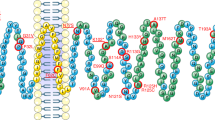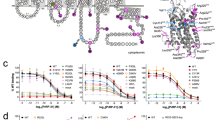Abstract
Several genetic diseases are triggered by nonsense mutations leading to the formation of truncated and defective proteins. Aminoglycosides have the capability to mediate a bypass of stop mutations during translation thus resulting in a rescue of protein expression. So far no attention has been directed to obesity-associated stop mutations as targets for nonsense suppression. Herein, we focus on the characterization of the melanocortin-4-receptor (MC4R) nonsense allele W16X identified in obese subjects. Cell culture assays revealed a loss-of-function of Mc4rX16 characterized by impaired surface expression and defect signaling. The aminoglycoside G-418 restored Mc4rX16 function in vitro demonstrating that Mc4rX16 is susceptible to nonsense suppression. For the evaluation of nonsense suppression in vivo, we generated a Mc4rX16 knock-in mouse line by gene targeting. Mc4rX16 knock-in mice developed hyperphagia, impaired glucose tolerance, severe obesity and an increased body length demonstrating that this new mouse model resembles typical characteristics of Mc4r deficiency. In a first therapeutic trial, the aminoglycosides gentamicin and amikacin induced no amelioration of obesity. Further experiments with Mc4rX16 knock-in mice will be instrumental to establish nonsense suppression for Mc4r as an obesity-associated target gene expressed in the central nervous system.
This is a preview of subscription content, access via your institution
Access options
Subscribe to this journal
Receive 6 print issues and online access
$259.00 per year
only $43.17 per issue
Buy this article
- Purchase on Springer Link
- Instant access to full article PDF
Prices may be subject to local taxes which are calculated during checkout











Similar content being viewed by others
References
Tsui LC . The spectrum of cystic fibrosis mutations. Trends Genet 1992; 8: 392–398.
Scott HS, Litjens T, Nelson PV, Brooks DA, Hopwood JJ, Morris CP . Alpha-L-iduronidase mutations (Q70X and P533R) associate with a severe Hurler phenotype. Hum Mutat 1992; 1: 333–339.
Wildin RS, Antush MJ, Bennett RL, Schoof JM, Scott CR . Heterogeneous AVPR2 gene mutations in congenital nephrogenic diabetes insipidus. Am J Hum Genet 1994; 55: 266–277.
Prior TW, Bartolo C, Pearl DK, Papp AC, Snyder PJ, Sedra MS et al. Spectrum of small mutations in the dystrophin coding region. Am J Hum Genet 1995; 57: 22–33.
Barton-Davis ER, Cordier L, Shoturma DI, Leland SE, Sweeney HL . Aminoglycoside antibiotics restore dystrophin function to skeletal muscles of mdx mice. J Clin Invest 1999; 104: 375–381.
Manuvakhova M, Keeling K, Bedwell DM . Aminoglycoside antibiotics mediate context-dependent suppression of termination codons in a mammalian translation system. RNA 2000; 6: 1044–1055.
Du M, Keeling KM, Fan L, Liu X, Kovacs T, Sorscher E et al. Clinical doses of amikacin provide more effective suppression of the human CFTR-G542X stop mutation than gentamicin in a transgenic CF mouse model. J Mol Med 2006; 84: 573–582.
Keeling KM, Bedwell DM . Clinically relevant aminoglycosides can suppress disease-associated premature stop mutations in the IDUA and P53 cDNAs in a mammalian translation system. J Mol Med 2002; 80: 367–376.
Mankin AS, Liebman SW . Baby, don’t stop!. Nat Genet 1999; 23: 8–10.
Hutchin T, Cortopassi G . Proposed molecular and cellular mechanism for aminoglycoside ototoxicity. Antimicrob Agents Chemother 1994; 38: 2517–2520.
Mingeot-Leclercq MP, Tulkens PM . Aminoglycosides: nephrotoxicity. Antimicrob Agents Chemother 1999; 43: 1003–1012.
Welch EM, Barton ER, Zhuo J, Tomizawa Y, Friesen WJ, Trifillis P et al. PTC124 targets genetic disorders caused by nonsense mutations. Nature 2007; 447: 87–91.
Hirawat S, Welch EM, Elfring GL, Northcutt VJ, Paushkin S, Hwang S et al. Safety, tolerability, and pharmacokinetics of PTC124, a nonaminoglycoside nonsense mutation suppressor, following single- and multiple-dose administration to healthy male and female adult volunteers. J Clin Pharmacol 2007; 47: 430–444.
Arakawa M, Shiozuka M, Nakayama Y, Hara T, Hamada M, Kondo S et al. Negamycin restores dystrophin expression in skeletal and cardiac muscles of mdx mice. J Biochem 2003; 134: 751–758.
Kopelman PG . Obesity as a medical problem. Nature 2000; 404: 635–643.
Hebebrand J, Hinney A . Environmental and genetic risk factors in obesity. Child Adolesc Psychiatr Clin N Am 2009; 18: 83–94.
Hinney A, Schmidt A, Nottebom K, Heibult O, Becker I, Ziegler A et al. Several mutations in the melanocortin-4 receptor gene including a nonsense and a frameshift mutation associated with dominantly inherited obesity in humans. J Clin Endocrinol Metab 1999; 84: 1483–1486.
Jackson RS, Creemers JW, Farooqi IS, Raffin-Sanson ML, Varro A, Dockray GJ et al. Small-intestinal dysfunction accompanies the complex endocrinopathy of human proprotein convertase 1 deficiency. J Clin Invest 2003; 112: 1550–1560.
Krude H, Biebermann H, Schnabel D, Tansek MZ, Theunissen P, Mullis PE et al. Obesity due to proopiomelanocortin deficiency: three new cases and treatment trials with thyroid hormone and ACTH4-10. J Clin Endocrinol Metab 2003; 88: 4633–4640.
Farooqi IS, Wangensteen T, Collins S, Kimber W, Matarese G, Keogh JM et al. Clinical and molecular genetic spectrum of congenital deficiency of the leptin receptor. N Engl J Med 2007; 356: 237–247.
Marti A, Corbalan MS, Forga L, Martinez JA, Hinney A, Hebebrand J . A novel nonsense mutation in the melanocortin-4 receptor associated with obesity in a Spanish population. Int J Obes Relat Metab Disord 2003; 27: 385–388.
Hinney A, Hohmann S, Geller F, Vogel C, Hess C, Wermter AK et al. Melanocortin-4 receptor gene: case-control study and transmission disequilibrium test confirm that functionally relevant mutations are compatible with a major gene effect for extreme obesity. J Clin Endocrinol Metab 2003; 88: 4258–4267.
Mountjoy KG, Mortrud MT, Low MJ, Simerly RB, Cone RD . Localization of the melanocortin-4 receptor (MC4-R) in neuroendocrine and autonomic control circuits in the brain. Mol Endocrinol 1994; 8: 1298–1308.
Smith AI, Funder JW . Proopiomelanocortin processing in the pituitary, central nervous system, and peripheral tissues. Endocr Rev 1988; 9: 159–179.
Marsh DJ, Hollopeter G, Huszar D, Laufer R, Yagaloff KA, Fisher SL et al. Response of melanocortin-4 receptor-deficient mice to anorectic and orexigenic peptides. Nat Genet 1999; 21: 119–122.
Chen AS, Metzger JM, Trumbauer ME, Guan XM, Yu H, Frazier EG et al. Role of the melanocortin-4 receptor in metabolic rate and food intake in mice. Transgenic Res 2000; 9: 145–154.
Huszar D, Lynch CA, Fairchild-Huntress V, Dunmore JH, Fang Q, Berkemeier LR et al. Targeted disruption of the melanocortin-4 receptor results in obesity in mice. Cell 1997; 88: 131–141.
Grosse J, Tarnow P, Rompler H, Schneider B, Sedlmeier R, Huffstadt U et al. N-ethyl-N-nitrosourea-based generation of mouse models for mutant G protein-coupled receptors. Physiol Genomics 2006; 26: 209–217.
Tao YX . The melanocortin-4 receptor: physiology, pharmacology, and pathophysiology. Endocr Rev 2010; 31: 506–543.
Mul JD, van BR, Bergen DJ, Brans MA, Brakkee JH, Toonen PW et al. Melanocortin receptor 4 deficiency affects body weight regulation, grooming behavior, and substrate preference in the rat. Obesity 2011; doi:10.1038/oby.2011.81.
Eggan K, Akutsu H, Loring J, Jackson-Grusby L, Klemm M, Rideout III WM et al. Hybrid vigor, fetal overgrowth, and viability of mice derived by nuclear cloning and tetraploid embryo complementation. Proc Natl Acad Sci USA 2001; 98: 6209–6214.
Heldmaier G, Ruf T . Body temperature and metabolic rate during natural hypothermia in endotherms. J Comp Physiol B 1992; 162: 696–706.
La Rocca PT, Baker F, Frantz JD, Szot RJ, Black HE, Schwartz E . Skin and mucous membrane ulceration in beagle dogs following oral dosing with an experimental aminoglycoside antibiotic. Fundam Appl Toxicol 1985; 5: 986–990.
Brumm H, Muhlhaus J, Bolze F, Scherag S, Hinney A, Hebebrand J et al. Rescue of Melanocortin 4 receptor (MC4R) nonsense mutations by aminoglycoside-mediated read-through. Obesity 2011; doi:10.1038/oby.2011.202.
Ollmann MM, Wilson BD, Yang YK, Kerns JA, Chen Y, Gantz I et al. Antagonism of central melanocortin receptors in vitro and in vivo by agouti-related protein. Science 1997; 278: 135–138.
Ste ML, Miura GI, Marsh DJ, Yagaloff K, Palmiter RD . A metabolic defect promotes obesity in mice lacking melanocortin-4 receptors. Proc Natl Acad Sci USA 2000; 97: 12339–12344.
Weide K, Christ N, Moar KM, Arens J, Hinney A, Mercer JG et al. Hyperphagia, not hypometabolism, causes early onset obesity in melanocortin-4 receptor knockout mice. Physiol Genomics 2003; 13: 47–56.
Butler AA, Kozak LP . A recurring problem with the analysis of energy expenditure in genetic models expressing lean and obese phenotypes. Diabetes 2010; 59: 323–329.
Kaiyala KJ, Morton GJ, Leroux BG, Ogimoto K, Wisse B, Schwartz MW . Identification of body fat mass as a major determinant of metabolic rate in mice. Diabetes 2010; 59: 1657–1666.
Hakansson ML, Hulting AL, Meister B . Expression of leptin receptor mRNA in the hypothalamic arcuate nucleus—relationship with NPY neurones. Neuroreport 1996; 7: 3087–3092.
Wilson BD, Bagnol D, Kaelin CB, Ollmann MM, Gantz I, Watson SJ et al. Physiological and anatomical circuitry between Agouti-related protein and leptin signaling. Endocrinology 1999; 140: 2387–2397.
Cheung CC, Clifton DK, Steiner RA . Proopiomelanocortin neurons are direct targets for leptin in the hypothalamus. Endocrinology 1997; 138: 4489–4492.
Tsuruta Y, Yoshimatsu H, Hidaka S, Kondou S, Okamoto K, Sakata T . Hyperleptinemia in A(y)/a mice upregulates arcuate cocaine- and amphetamine-regulated transcript expression. Am J Physiol Endocrinol Metab 2002; 282: E967–E973.
Haskell-Luevano C, Schaub JW, Andreasen A, Haskell KR, Moore MC, Koerper LM et al. Voluntary exercise prevents the obese and diabetic metabolic syndrome of the melanocortin-4 receptor knockout mouse. FASEB J 2009; 23: 642–655.
Hentze MW, Kulozik AE . A perfect message: RNA surveillance and nonsense-mediated decay. Cell 1999; 96: 307–310.
Brocke KS, Neu-Yilik G, Gehring NH, Hentze MW, Kulozik AE . The human intronless melanocortin 4-receptor gene is NMD insensitive. Hum Mol Genet 2002; 11: 331–335.
Zhang Y, Collazo R, Gao Y, Li G, Scarpace PJ . Intermittent MTII application evokes repeated anorexia and robust fat and weight loss. Peptides 2010; 31: 639–643.
Meehan TP, Tabeta K, Du X, Woodward LS, Firozi K, Beutler B et al. Point mutations in the melanocortin-4 receptor cause variable obesity in mice. Mamm Genome 2006; 17: 1162–1171.
Du M, Jones JR, Lanier J, Keeling KM, Lindsey JR, Tousson A et al. Aminoglycoside suppression of a premature stop mutation in a Cftr−/− mouse carrying a human CFTR-G542X transgene. J Mol Med 2002; 80: 595–604.
Bruckner O, Alexander M, Martens F . Gentamicin concentrations in cerebrospinal fluid of patients with inflamed and uninflamed meninges (author's transl). Infection 1980; 8: 86–89.
Briedis DJ, Robson HG . Cerebrospinal fluid penetration of amikacin. Antimicrob Agents Chemother 1978; 13: 1042–1043.
Strausbaugh LJ, Brinker GS . Effect of osmotic blood-brain barrier disruption on gentamicin penetration into the cerebrospinal fluid and brains of normal rabbits. Antimicrob Agents Chemother 1983; 24: 147–150.
Shaver SW, Pang JJ, Wainman DS, Wall KM, Gross PM . Morphology and function of capillary networks in subregions of the rat tuber cinereum. Cell Tissue Res 1992; 267: 437–448.
Acknowledgements
This work was supported by the Bundesministerium für Bildung und Forschung within the framework of the National Genome Research Network NGFNplus to Martin Klingenspor (01GS0822), Wolfgang Wurst (01GS0823) and to Heike Biebermann (01GS0825). We also would like to thank the BMBF/DLR for their support to Wolfgang Wurst (01GS0858).
Author information
Authors and Affiliations
Corresponding author
Ethics declarations
Competing interests
The authors declare no conflict of interest.
PowerPoint slides
Rights and permissions
About this article
Cite this article
Bolze, F., Rink, N., Brumm, H. et al. Characterization of the melanocortin-4-receptor nonsense mutation W16X in vitro and in vivo. Pharmacogenomics J 13, 80–93 (2013). https://doi.org/10.1038/tpj.2011.43
Received:
Revised:
Accepted:
Published:
Issue Date:
DOI: https://doi.org/10.1038/tpj.2011.43
Keywords
This article is cited by
-
Proximate causes for diet-induced obesity in laboratory mice: a case study
European Journal of Clinical Nutrition (2017)
-
Aminoglycosides, but not PTC124 (Ataluren), rescue nonsense mutations in the leptin receptor and in luciferase reporter genes
Scientific Reports (2017)



